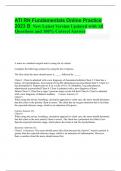Exam (elaborations)
ATI RN Fundamentals Online Practice 2023 B New Latest Version Updated with All Questions and 100% Correct Answer
- Course
- Institution
ATI RN Fundamentals Online Practice 2023 B New Latest Version Updated with All Questions and A nurse in a medical-surgical unit is caring for six clients. Complete the following sentence by using the list of options. The first client the nurse should assess is _____ followed by _____. Cli...
[Show more]



